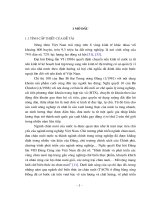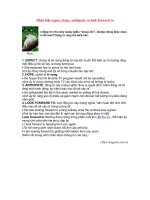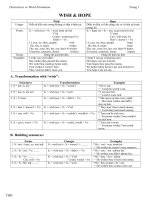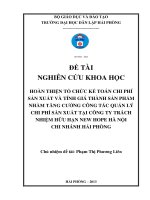Hope
Bạn đang xem bản rút gọn của tài liệu. Xem và tải ngay bản đầy đủ của tài liệu tại đây (148.9 KB, 21 trang )
HOPE
By John Galsworthy
(1867-1933)
JOHN GALSWORTHY
(1867-1933)
• John Galsworthy
(August 14, 1867 –
January 31 1933) was
an English novelist
and playwright.
• He won the Nobel
Prize in Literature in
1932.
JOHN GALSWORTHY
(1867-1933)
• Real literary career of John Galsworthy began in 1904 with
his novel called "The Island Pharisees"(Island of the
hypocrites), with this work ,Galsworthy signed his real
name.
• The most famous novel of him is "The Forsyte Saga"(Family
Stories Forsyte) including 5 works:
- three novels The Man Of Property (The property
ownership, 1906), In Chancery (In noose, 1920), To Let
(rent, 1921).
- two short stories Indian summer of a Forsyte (late summer
of Forsyte, 1917) and Awakening (Awakening, 1920).
JOHN GALSWORTHY
(1867-1933)
• His writing is photographic rather than
moving. He writes what he observed not
pass judgment upon it. He sets down the
facts and leaves them to the reader to
judge for himself.
• His theme are human but they are not
stimming or romantic.
• His material is that of normal daily
existence and he treats it in exact detail
often in trivial details.
The theme of "Hope"
"Hope" is a short story written by John
Galsworthy included in a book called “A
commentary”. The story’s title is Hope,
however it illustrates a picture of a poor lame
man. He used to be a deep sea fisherman.
After an accident, his leg had shrunk and had
become two inches shorter than it should have
been. Getting away from sea, he dragged his
shrunken limb through the ground to find
groundsels – food for caged canaries, to earn
some pennies for him and his wife’s life.
Through the story, the seaman appears as a
hard-working and industrious; self-respected;
responsible; optimistic; and courageous man.
The plot of "Hope"
The man gets up at 5 a.m.
He goes out of London by an early tram to
start a journey of amassing the small
green plants with its yellow centered
heads.
He returns to the city and stood patiently
waiting an entire day for customers.
The characters:
A.The man described in the story:
he is described as a lame man with
wholesome weather -beater face and a
shrinken leg.
everything on him was ragged from long
use and stained by weather.
there was nothing special about his
appearance.
The characters:
B. The chief qualities in the character of the old
man:
1. He is very hard-working and industrious:
"He would stoop and toifully amass the small
green plants with its yellow centered heads" ,
then he would take a tram back home.
"He made his living by standing on the
pavement at a certain spot, in Bayswater, from
ten o'clock to seven in the evening."
He has no holidays, only take rest when his leg
has "a mass of pain"
The characters:
2. He is self-respected:
In the society , there are a lot of people
working as beggars even there are also
the people who pretend to be disable to be
beggars. But the old man in this story is
self-respected.
He is a lame man but he works to earn his
living, he does not ask pity from other
people. He does not stand in the street
and works as a beggar.
The characters:
3. He is responsible:
For the family:
The man goes out to earn money for
family although he is lame.
He worries a lot for his wife and takes
care of her when she is sick "What he
thought about when he stood there of his
wife's gouty....and herrings for his tea of
his arrears of rent."
The characters:
For the birds:
He always tries to find good groundsel for
the birds.
After sickness, he usually tries to go for
fields and tries to find something that the
birds needn't despire, underestimate.
The characters:
4. He is optimistic:
Many times, because of hardness, he
thought "Sometimes I would like leave my
leg behind". "I was so sick I couldn't seem
to drag it though the mud at all"
"And summoning an expected spirit of
cheerfulness." he smiled
The characters:
• "You see, it's got no strength in it at allthere's not a bit of muscle left - very few
people have got a leg like this".
• Living in hard life, many people feel
despair and porrow, the man always thinks
that '"we can't be worse off where we're
going".
The characters:
5. He is tolerant and patient:
He has a hard life . He has to earn money by
collecting groundsels in the field with a lame
leg but he never complains about anything.
"Wet or fine, hot or cold, nothing was more
certain than that the lame man would pass,
leaning on his oaken stick, his wicker basket
hanging from his shoulders."
The characters:
6. He has a strong will and love of life:
• He dubiously remarks: "My wife always
telling me we can't be worse off where
we're going. And she's right, no doubt, if
so be as we're going anywhere."
• "Why do I continue living" never came to
him.
Literary Appriciation:
1. The old man was described as a lame
man with his wholesome weather beaten
face and a shrunken leg. Everything on
him was ragged, worn out from long use
stained by weather. There was nothing
special about his appearance .
Literary Appriciation:
2. The chief characters of the old man: hardworking, industrious (collecting groundsels,
standing on the pavement, selling
groundsels, no holiday), optimistic, selfrespect, self-reliant, responsible for the
family and birds (looking after his sick wife,
trying to find good groundsels for birds),
tolerant (never complain), patient (at any
time, in any weather, going field),
energetic, strong will, love for life.
Literary Appriciation:
3. The old man represents for the great
unconscious human virtue and courage.
4. Feelings that the author wants to express
towards the old man are: sympathy,
respect and admiration. The man was
described as "a ragged statue to the great
conscious human virtue, the most hopeful
and inspiring of al on earth".
Literary Appriciation:
5. The passers-by were selfish,
inconsiderate, indifferent and mean. They
did not show any sympathy for the lame
man.
Literary Appriciation:
6. The author's main techniques:
Comparison: the bird (with its dipped
wings) and the man (with his shrunken
leg). The bird love the sky, the man loved
the sea.
Metaphor: the man's life and groundsel's
life: a hard life. "There does not seem any
life in the stuff, the frosts have spoiled it".









